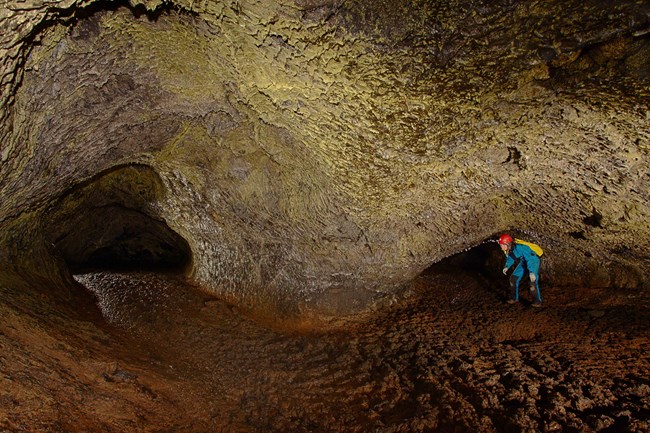Last updated: February 22, 2022
Article
Actinobacteria

Photo courtesy of Kenneth Ingham
General Description
What do humans have in common with caves? We are covered in bacteria! One square centimeter of human skin is covered in an estimated one billion individual bacterium. According to Diana Northup, Geomicrobiologist at the University of New Mexico, “the walls of the caves in Lava Beds [National Monument] are alive with microbes whose numbers exceed all the humans on the Earth!” One group of bacteria that lives on the surface of our skin are Actinobacteria. Actinobacteria is a phylum in the domain Bacteria. The diversity of Actinobacteria is immense. Within this phylum you find bacteria that cause tuberculosis and diphtheria, bacteria that produce antibiotics, and bacteria that fix nitrogen (take nitrogen from the air and convert it into a form usable by plants).
Actinobacteria exist as either dormant spores or actively growing mycelium with filaments called hyphae. Most of these free-living organisms look like strands of hair or spaghetti under a microscope. Some are spherical in shape, others are branched, and many have knobby or hair-like projections. Actinobacteria can produce microbial mats on the walls and ceilings of caves that can be pink, yellow, orange, tan, or white in color.
Habitat and Distribution
Actinobacteria are abundant in nature, both on land and in water. They can be found in the extreme cold of the arctic, boiling hot springs, and salty seas. They are found in the soil, and even in our intestinal tracts! Some Actinobacteria thrive in environments that maintain a stable temperature between 10 and 15°C (50–59°F) and with relatively high humidity. These are precisely the conditions found in the volcanic caves at Lava Beds National Monument. Different bacteria colonize different rock surfaces based on the rock’s chemistry and the needs of the bacteria.
Feeding Strategy
Most Actinobacteria are heterotrophic, meaning they are unable to manufacture their own food and must obtain nutrients from the environment. They usually absorb nutrients through their cell walls! Actinobacteria feed on organic carbon. Some obtain carbon from the air. Other Actinobacteria feed on plant material that makes its way into the cave, or carbon that is dissolved in dripping water.

Photo courtesy of Michael Spilde and Diana E. Northup
Reproduction
Actinobacteria do not sexually reproduce. Instead, they reproduce via fragmentation or the production of spores. Many Actinobacteria produce a mycelium. Mycelia are made up of many filaments called hyphae that make up the structure of the bacteria. They look like a web of white filaments, similar to the roots of a plant. Mycelia can reproduce via fragmentation, which means the organism splits into two or more pieces that each become their own functioning mycelium. A similar example would be cut willow branches that can be planted to establish a new willow plant. This type of reproduction will occur when conditions are favorable in the environment. When nutrition is limited in the environment, mycelium may produce spores that can remain dormant until conditions are more favorable. These spores will not germinate until environmental conditions improve. Spore germination is very complex. When conditions are favorable the spore is able to resume metabolic activity and grow out to form vegetative hyphae. These hyphae make up the new mycelium.
Fun Facts
- Actinobacteria produce secondary metabolites—organic compounds that serve no purpose to the bacteria itself. However, many secondary metabolites can be useful to humans and other animals. Actinobacteria produce secondary metabolites that have antibiotic, antifungal, and anticancer qualities.
- Some Actinobacteria have mutualistic relationships with organisms where both species benefit. For example, leafcutter ants have an interesting relationship with Actinobacteria. Leafcutter ants bring leaf cuttings underground. These leaf cuttings grow a fungus that the ants then eat. These “fungal gardens” can be parasitized by other types of fungi. In response, the ants use the antibiotic compounds formed by Actinobacteria to “weed out” the parasitic fungi.
Where to See
Bacterial mats that contain Actinobacteria can be seen on cave walls at Lava Beds National Monument and Oregon Caves National Monument and Preserve. Look for tan, white, and yellow surfaces near moist areas of the cave.
More information
https://www.smithsonianmag.com/travel/how-bacteria-make-underground-cave-shine-gold-and-why-nasa-wants-study-them-180955670/
https://www.nytimes.com/2018/10/06/science/ants-fungus-amber.html
Download a pdf of this article
Prepared by Emily Lind, Southern Oregon University science communication intern
NPS Klamath Inventory & Monitoring Network
Southern Oregon University
1250 Siskiyou Blvd
Ashland, OR 97520
Featured Creature Edition: June 2019
